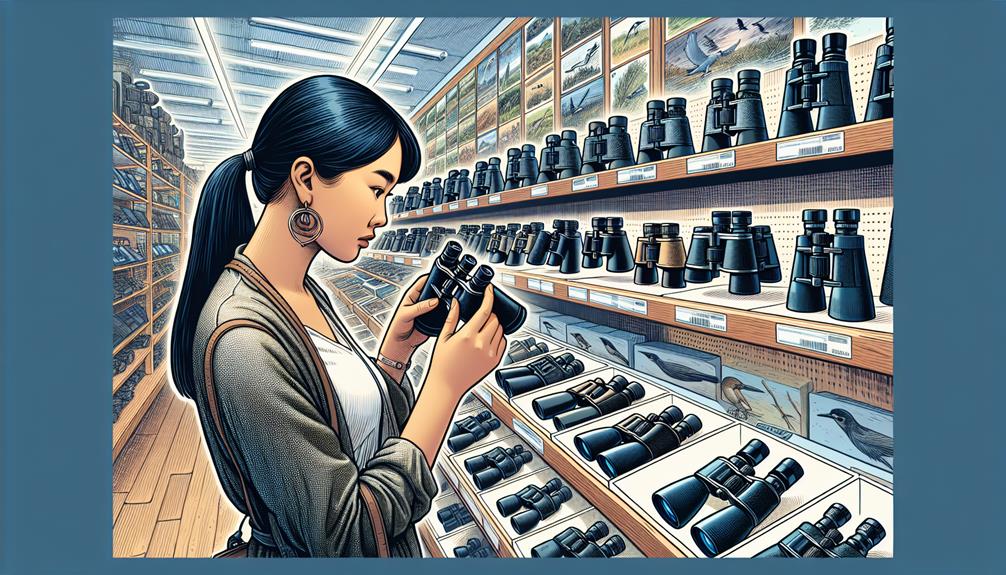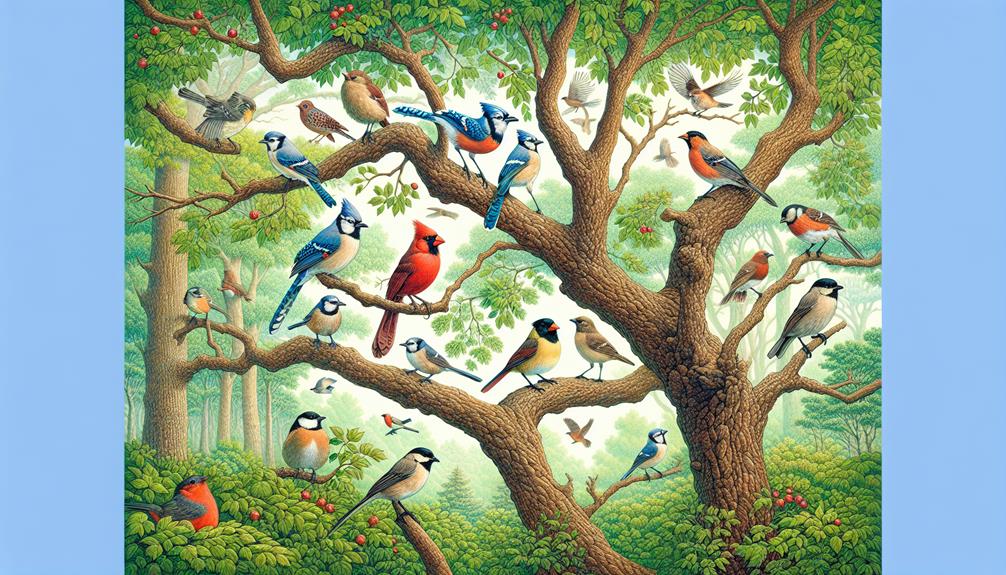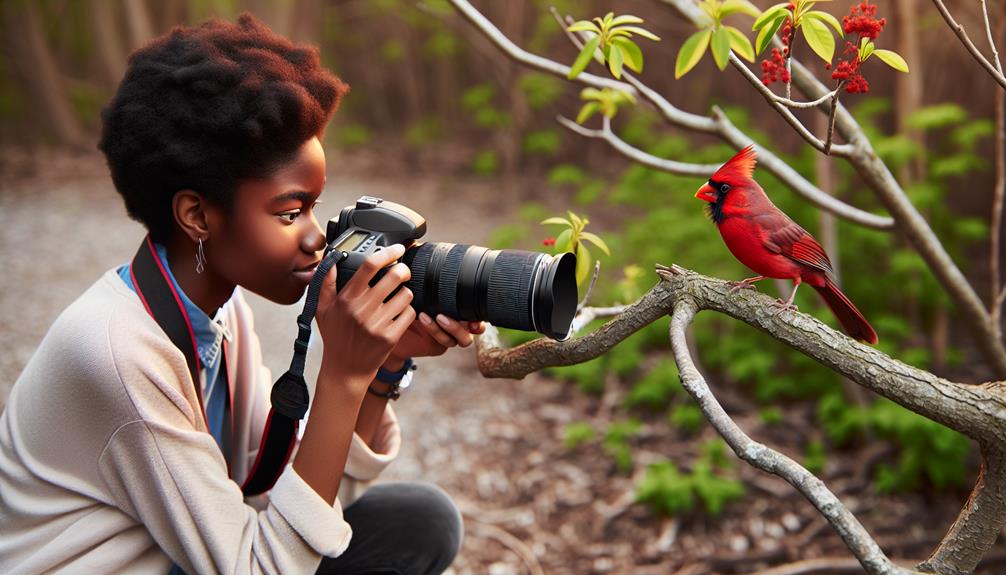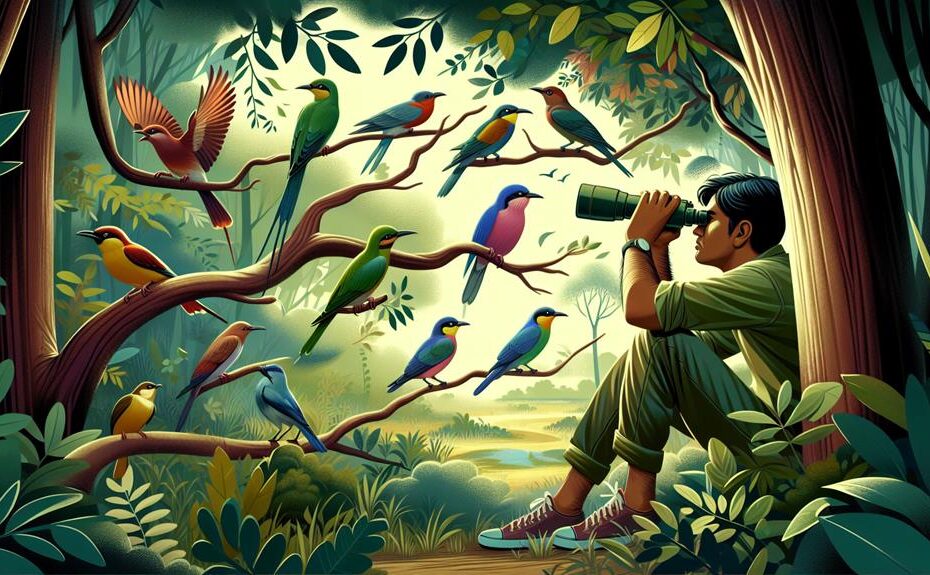If you’re new to bird watching, did you know that observing birds can actually improve your mental well-being and provide a sense of calm? Exploring the world of birding offers a unique opportunity to connect with nature in a meaningful way. As you embark on this journey, you’ll soon discover the joy of discovering new species and observing their fascinating behaviors. Stay tuned to learn how to enhance your bird watching experience and make the most out of this mindful practice.
Key Takeaways
- Practice mindfulness in bird watching for mental clarity and relaxation.
- Start with basic binoculars and a field guide for cost-effective birding.
- Engage in bird watching to foster a connection with nature.
- Join birding groups for shared experiences and enhanced skills.
- Keep a bird watching journal for reflections and improving identification skills.
Benefits of Bird Watching

Engaging in bird watching provides enthusiasts with a myriad of mental health benefits, including stress reduction, increased mindfulness, and a sense of connection with nature.
The mindfulness benefits of bird watching are profound, as it encourages you to be fully present in the moment, focusing on the intricate details of each bird’s behavior and appearance. This practice promotes mental clarity and relaxation, leading to a calmer state of mind.
Furthermore, being part of the birding community offers a unique sense of camaraderie and belonging. Sharing sightings, tips, and experiences with fellow bird watchers fosters a supportive network that enhances the overall enjoyment of the hobby. This connection with like-minded individuals not only enriches your birding adventures but also contributes to your social well-being.
In addition to the mindfulness benefits, bird watching also promotes physical health through increased time spent outdoors. Breathing in fresh air, soaking up sunlight, and walking along trails all contribute to improved physical well-being. This direct exposure to nature enhances your connection with the environment, fostering a deeper appreciation for the natural world around you.
Essential Gear for Beginners
When starting your bird watching journey, selecting the right gear is crucial for a successful experience. Understanding gear selection tips, exploring budget-friendly options, and knowing the must-have accessories will enhance your bird watching outings.
Gear Selection Tips
Selecting the appropriate gear is crucial for beginners venturing into the world of bird watching. To enhance your birding experience, consider the following gear selection tips:
- Binoculars:
Opt for lightweight binoculars with a magnification power of 8x to 10x and objective lens diameter of 42mm for a clear view of birds in their natural habitats. Ensure your binoculars are waterproof and have a comfortable grip for extended use during outdoor activities. - Field Guide:
Invest in a comprehensive field guide specific to the region you plan to bird watch in. This will help you identify different bird species, understand their behavior, and respect birding etiquette, such as maintaining a safe distance and avoiding disturbances in their habitats. - Notebook and Pen:
Keep a notebook and pen handy to jot down observations, record bird sightings, and sketch unique features. This aids in gear maintenance by allowing you to track your birding progress and learn more about the birds you encounter.
Budget-Friendly Options
For beginners on a budget, prioritizing essential gear is key to kickstarting your bird watching journey with efficiency and cost-effectiveness.
When delving into the world of birding, consider DIY bird feeders as a budget-friendly option to attract a variety of species to your backyard. Crafting simple feeders using materials like plastic bottles, wood scraps, or even recycled containers can’t only save you money but also provide a sustainable food source for local birds.
Backyard birding is a fantastic starting point for beginners, as it offers a convenient and affordable way to observe bird behavior from the comfort of your own home.
Investing in a basic pair of binoculars and a field guide can enhance your backyard birding experience without breaking the bank. These tools will help you identify different bird species and learn more about their habits and habitats.
Must-Have Accessories
Consider prioritizing essential gear to kickstart your bird watching journey with efficiency and cost-effectiveness. To enhance your birding experience, investing in the right accessories can make a significant difference.
Here are three must-have items for beginners:
- Bird Watching Backpacks: A good quality backpack designed for bird watchers is essential to carry all your gear comfortably. Look for features like padded straps, multiple compartments for organizing your equipment, and waterproof material to protect your gear from the elements.
- Field Guides: Field guides are invaluable resources for identifying birds in the wild. Opt for a comprehensive guide with detailed descriptions, illustrations, and information on bird species, habitats, and behavior. Consider guides specific to your region for more accurate identification.
- Binoculars: A pair of binoculars is perhaps the most crucial tool for bird watching. Invest in a pair with good magnification, wide field of view, and comfortable eye relief for extended use. Quality optics can greatly enhance your bird watching experience by allowing you to observe birds up close with clarity.
Choosing the Right Binoculars

When selecting binoculars for bird watching, beginners should consider key features like magnification power, lens diameter, and field of view. These factors will determine how well you can observe birds in their natural habitats and identify different species.
Luckily, there are budget-friendly options available that still offer good quality for those starting out in this rewarding hobby.
Binoculars for Beginners
Selecting the appropriate binoculars is crucial for beginner bird watchers to enhance their observation experience.
When choosing binoculars, consider their maintenance and adjustment for optimal performance:
- Binocular Maintenance: Proper maintenance is essential for the longevity of your binoculars. Regularly clean the lenses with a microfiber cloth to remove dust and smudges. Store them in a protective case when not in use to prevent damage.
- Proper Adjustment: Ensure your binoculars are correctly adjusted to your eyesight. Adjust the interpupillary distance to match your eyes and focus each eyepiece independently for a clear, sharp image.
- Brand Comparisons: Research different brands to find one that suits your needs. Compare features such as magnification power, lens quality, and durability. Look for reputable brands known for producing high-quality optics.
Features to Consider
Exploring the optical features of binoculars is crucial in identifying the right pair for your bird watching endeavors. When it comes to bird identification and nature observation, there are specific factors to consider in binoculars.
Firstly, the magnification power of the binoculars plays a significant role. For bird watching, magnifications between 8x and 10x are recommended, as they offer a good balance between zoom capability and field of view.
Secondly, consider the objective lens diameter. A larger lens diameter allows more light to enter, resulting in brighter images, crucial for low-light birding sessions. Lens coatings are also essential; look for fully multi-coated lenses to reduce glare and ensure a clear image.
Moreover, the field of view is crucial for tracking birds in motion. A wider field of view provides a better chance of following birds in flight or when they’re on the move.
Lastly, consider the close focus distance, as this determines how close you can focus on objects, allowing for detailed observations of birds and their behavior.
Budget-Friendly Options
Consider starting your search for budget-friendly binoculars by focusing on key optical features that provide quality performance without breaking the bank.
When choosing binoculars for bird watching on a budget, keep an eye out for the following:
- Magnification: Opt for binoculars with a moderate magnification level, such as 8x or 10x, which strikes a balance between zoom capabilities and image stability.
- Objective Lens Diameter: Look for binoculars with an objective lens diameter of around 42mm. This size offers a good compromise between light-gathering ability and portability.
- Prism Type: Consider binoculars with roof prisms for a more compact design, making them easier to carry during nature walks and bird watching excursions.
Understanding Bird Behavior
To truly appreciate and enjoy bird watching, it is essential to observe and understand the various behaviors exhibited by different bird species. Two key behaviors to observe are bird migration and nesting habits. Bird migration refers to the seasonal movement of birds from one place to another, often driven by changes in food availability, breeding grounds, or weather conditions. Understanding the timing and routes of bird migration can enhance your bird watching experience, allowing you to witness unique species passing through your area.
Another important behavior to observe is nesting habits. Different bird species exhibit a wide range of nesting preferences, including the type of nest constructed, the location chosen, and the materials used. By learning about the nesting habits of birds in your region, you can locate and observe nests, witness breeding behaviors, and even observe the development of chicks.
| Behavior | Description |
|---|---|
| Bird Migration | Seasonal movement of birds for various reasons such as breeding or weather. |
| Nesting Habits | Diverse preferences in nest type, location, and materials by different species. |
Identifying Common Bird Species

As you begin your journey in bird watching, mastering the art of identifying common bird species is essential.
Pay close attention to common bird features such as plumage colors, beak shapes, and wing patterns.
Additionally, familiarize yourself with the distinct calls and songs of different bird species to enhance your identification skills.
Bird Species Identification
When identifying common bird species, focus on key physical characteristics such as color patterns, size, and beak shape. To help you in this process, here are some essential tips:
- Feather Colors:
- Bright Plumage: Look for birds with vibrant colors like red, blue, or yellow. These hues often serve as important markers for species identification.
- Muted Tones: Some birds have more subtle feather colors, such as browns and grays, which can be key indicators of specific species.
- Distinct Markings: Pay attention to unique patterns like stripes, spots, or patches of color on the feathers, as these can differentiate between similar-looking birds.
Common Bird Features
When identifying common bird species, pay close attention to distinct physical features that can aid you in accurate species identification, such as specific behavioral characteristics, wing shapes, and unique markings.
Bird colors play a crucial role in identification. For instance, the vibrant red plumage of a cardinal or the bright yellow of a goldfinch are key markers. Bird sizes are equally important; sparrows are small and slender, while crows are larger and robust. Understanding these basic differences will greatly assist you in recognizing various bird species.
Birds often exhibit specific behavioral traits unique to their species. Some birds may hop on the ground looking for insects, while others prefer to soar high in the sky. Observing these behaviors can provide valuable clues for identification. Additionally, wing shapes vary among species; some birds have pointed wings for swift flight, while others have rounded wings for better maneuverability.
Unique markings like eye stripes, breast patterns, or tail shapes are also essential identifiers when distinguishing between common bird species. By honing in on these features, you can become adept at recognizing different birds in the wild.
Recognizing Bird Calls
To accurately identify common bird species, listen attentively to their distinct calls, as they can serve as key identifiers in bird watching. Bird call identification is a crucial skill for enthusiasts. Here’s a quick guide to help you recognize common bird species by their calls:
- Pitch and Tone: Warblers often have high-pitched, melodious calls, while raptors like hawks and eagles have piercing, shrill cries.
- Rhythm and Pattern: Woodpeckers produce rhythmic drumming sounds, while owls hoot in a distinct pattern.
- Repetition and Variations: Sparrows often repeat short, simple phrases, whereas mockingbirds mimic various sounds in rapid succession.
For beginners, using bird watching apps can be incredibly helpful in learning and recognizing different bird calls. These apps often provide audio samples, visual references, and detailed descriptions to aid in your identification process.
Best Places to Bird Watch
For optimal bird watching experiences, seek out habitats with diverse ecosystems and abundant food sources. Birding hotspots and wildlife sanctuaries are ideal locations to observe a wide variety of bird species in their natural habitats. Urban birding, although surprising to some, can offer unique opportunities to spot different bird species adapting to city life. Even backyard birdwatching can be a rewarding experience, attracting local birds with feeders and bird-friendly plants.
| Location | Features | Notable Species |
|---|---|---|
| Birding Hotspots and Wildlife Sanctuaries | Diverse ecosystems with rich biodiversity and ample food sources | Rare and migratory bird species like the Scarlet Tanager or Snowy Owl |
| Urban Areas | Varied environments showcasing birds adapting to urban settings | Common city birds like the Rock Pigeon or European Starling |
| Backyards | Bird feeders, bird baths, and native plants attract local bird species | Sparrows, Chickadees, and Cardinals frequent backyard feeders |
Exploring these diverse locations can offer a well-rounded bird watching experience, from the serene wilderness of wildlife sanctuaries to the bustling activity of urban environments and the comfort of your own backyard.
Keeping a Bird Watching Journal

Consider using a dedicated notebook to meticulously record your bird sightings and observations in your bird watching journal. This journal will be a valuable tool in documenting your bird watching experiences and enhancing your knowledge about the avian world.
Here are three essential components to include in your bird watching journal:
- Nature Sketches: Capture the unique characteristics of the birds you encounter through detailed sketches. Note down key features such as beak shape, wing patterns, and distinctive markings. Sketching will help you remember the birds you’ve seen and improve your identification skills over time.
- Field Notes: Write detailed descriptions of the birds you observe, including their behavior, habitat preferences, and any interesting interactions you witness. Include the date, time, location, and weather conditions to provide context for your sightings. These field notes will serve as a valuable reference for future bird watching outings.
- Observations and Reflections: Use your journal to reflect on your bird watching experiences. Note down any new species you discover, challenges you encounter, or simply the joy you feel when observing these magnificent creatures in their natural habitat. Reflecting on your observations will deepen your connection to nature and foster a sense of mindfulness during your bird watching adventures.
Joining Bird Watching Groups
Participating in bird watching groups provides valuable opportunities for enhancing your birding skills and expanding your knowledge of avian species through shared experiences and insights. Group dynamics play a crucial role in these outings, as members often collaborate to spot and identify different bird species. By observing how others approach birding, you can learn new techniques and gain a deeper understanding of bird behaviors. Additionally, being part of a bird watching group introduces you to important birding etiquette, such as respecting wildlife habitats and minimizing disturbances to the environment.
Apart from skill development, joining bird watching groups fosters social connections with like-minded individuals who share your passion for nature appreciation. These groups often organize outings to various birding hotspots, allowing you to explore diverse ecosystems and encounter a wide range of bird species. The shared excitement of spotting rare birds or witnessing unique behaviors creates bonds among group members, enhancing your overall birding experience.
Embrace the opportunity to join bird watching groups, as they offer a wealth of knowledge, camaraderie, and memorable birding adventures.
Bird Photography Tips

Enhance your bird watching experience by mastering essential bird photography techniques for capturing stunning avian moments in the wild.
To elevate your bird photography skills, consider these key tips:
- Lighting Techniques: Utilize early morning or late afternoon light for soft, warm tones that enhance the beauty of the birds. Avoid harsh midday sunlight that can cause shadows and overexposure.
- Composition Tricks: Experiment with different angles and perspectives to create visually interesting photos. Use the rule of thirds to place the bird off-center for a more dynamic composition.
- Capturing Movement and Bird Portraits: To freeze a bird in motion, use a fast shutter speed and continuous shooting mode. For detailed bird portraits, focus on the eyes and try to capture the bird’s unique characteristics and expressions.
Conservation and Bird Watching
Explore the vital role of conservation efforts in preserving bird species while engaging in the rewarding activity of bird watching. Conservation efforts play a crucial role in maintaining healthy bird populations. By actively participating in bird watching, you contribute to the awareness and protection of these fascinating creatures.
Habitat preservation is key to safeguarding bird populations. As you observe birds in their natural environments, you witness firsthand the importance of conserving their habitats to ensure their survival.
Bird migration is a remarkable phenomenon that underscores the interconnectedness of ecosystems. Understanding the migratory patterns of birds can aid in conservation efforts by identifying critical stopover sites and nesting grounds. Through bird watching, you can appreciate the significance of these migration routes and advocate for their protection.
Frequently Asked Questions
Can Bird Watching Help Improve Mental Health and Well-Being?
Bird watching, a form of nature therapy, enhances mental health through mindfulness. Connecting with nature promotes serenity and relaxation. Observing birds provides a calming experience, fostering well-being and a sense of peace within yourself.
How Can Bird Watchers Attract More Birds to Their Backyard?
To attract more birds to your backyard, strategically place a variety of bird feeders filled with different seeds and nuts to cater to various species. Additionally, install a clean and fresh bird bath to provide water for drinking and bathing.
Are There Any Safety Tips for Bird Watchers in the Field?
When in the field, always remember field etiquette for wildlife encounters. Keep a safe distance, avoid sudden movements, and respect their space. Stay alert, carry essentials like water and first aid, and enjoy the experience mindfully.
What Role Do Weather Conditions Play in Bird Watching?
You might think sunny days are best for bird watching, but rain can bring out unique species. Weather affects bird behavior and habitat. Use bird identification techniques and practice patience in all conditions for a successful outing.
How Can Bird Watchers Contribute to Bird Conservation Efforts?
To contribute to bird conservation, as a bird watcher, you can engage in citizen science projects, participate in community involvement, support habitat preservation efforts, and take part in educational outreach programs to raise awareness and promote conservation.
Conclusion
In conclusion, embarking on the journey of bird watching as a beginner can lead to a profound connection with nature and a sense of mindfulness. By immersing yourself in the beauty of bird species and their behaviors, you can experience a tranquil escape from the chaos of daily life.
Remember, every feathered friend you encounter is a unique puzzle piece in the intricate tapestry of the avian world, waiting to be discovered and appreciated.
Happy birding!



